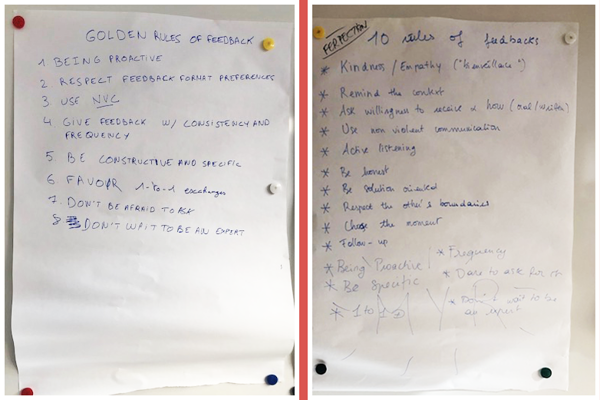December 8, 2022
Creating a Culture of Feedback in a Liberated Company
As a liberated company, we constantly try to improve and strive for creating an environment where feedback becomes embraced and people feel comfortable not also giving it but receiving as well. Unfortunately it is not an easy or straightforward task. Below are some of the lessons we learned while on the path to this goal.
Why is building a culture of feedback so hard?
Well, traditionally, many companies have relied heavily on annual reviews in order to communicate feedback. Unfortunately, this approach does not promote strong workplace communication. It can even stifle business growth, by leaving the employees (i.e. their most valuable resource) feeling unrecognized and unimportant.
The problem is that employees cannot learn and grow unless they receive constructive and frequent feedback. And the dramatic consequence of an absence of feedback is that many employees who feel ignored by their managers or co-workers become actively disengaged.
In 2017, a study conducted by Gallup (Gallup's State of the Global Workplace) measured the engagement levels of France’s workforce – defined as employee’s enthusiasm for the job and their emotional connection to the workplace. This study revealed that 6% of workers in France are engaged (while Europe’s average is 10%), 74% are not engaged and 20% are actively disengaged.
Today, it has become clear that encouraging feedback should be the #1 priority for companies of all sizes who want to create a positive, motivating and efficient workplace environment. Ignoring it could be one of the most serious barriers holding your company back.
Distance and remote work often make giving feedback less easy. No doubt that there are huge discrepancies in the consistency with which feedback is handed out in remote environments. Therefore constructive feedback can be even harder to come by for remote employees — which in turn means they enjoy the following benefits of constructive feedback more sporadically.
Additionally, most people are afraid of feedback. They think their colleagues will respond to even the mildest criticism with stonewalling, anger, or even tears. The consequence being that many people will tend to naturally avoid giving feedback. Fears and assumptions about feedback often manifest themselves in psychologically maladaptive behaviors such as aggressiveness, irritation, procrastination, denial, brooding, jealousy or self-sabotage.
That means that the first step for encouraging a culture of feedback should be to train everybody on how to give constructive and meaningful feedback messages.In essence, feedback should really always be like a gift. It should always aim at helping the other person grow. Otherwise, it will just be useless if not destructive.
Now, the question is :
How do we create a culture of feedback?
1. Start by giving more positive feedback!
The easiest way to start giving more feedback is to practice giving positive feedback.
Many people reject positive feedback as being useless and a waste of time. They will say things such as: “I am not the kind of person who makes compliments,” or “I am not going to congratulate them just for coming in on time!”
It’s really sad – and a little strange – that positive feedback may have such a bad reputation. The truth is that positive feedback is particularly effective at making employees feel confident, which helps them be more efficient. It makes them feel appreciated which in turn, builds trust, positivity and loyalty, all of which lead to higher retention. It also allows everyone to give critical or constructive feedback more easily, because everyone is used to hearing positive comments.
A Harvard Business School working paper, published on Sept. 17, found that appraisal from friends, family and colleagues causes “best-self activation,” which naturally encourages people to perform at their best. This study showed that people whose best-self concepts were activated had more energy, were more resilient to stress, healthier, more resistant to burnout, better at creative problem solving and performance under pressure, and formed stronger long-term relationships with their employer.
And what many people forget is that the downside of not giving positive feedback can be just as important. When you rarely give positive feedback that will mean that more often than not, your colleagues only hear from you when you give constructive or negative feedback. It is hard for many people to feel like they are improving if they only hear what their shortcomings are.2. Learn to celebrate failures!
The second step, maybe less intuitive but just as important, is to dedramatize feedback.
In order to do that, we should learn to celebrate mistakes and learn from failures.
Learning to celebrate failures is the single most important way to create a sense of “psychological safety” within a team. Psychological safety being defined as an individual’s belief that a team is safe for risk-taking in the face of being seen as ignorant, incompetent, negative, or disruptive. In a team with high psychological safety, teammates feel safe to take risks around their team members. They feel confident that no one on the team will embarrass or punish anyone else for admitting a mistake, asking a question, or offering a new idea.
In a study conducted by Google, code-named “Project Aristotle” - a tribute to Aristotle’s quote, "the whole is greater than the sum of its parts". The researchers found that what really mattered was less about who is on the team, and more about how the team worked together. The sense of Psychological safety being the n° 1 prerequisite to an effective team where communication is fluid and meaningful. Therefore if you want to create a culture of feedback, you should learn to fall and admit your vulnerabilities on a wide scale level!
There are many ways to do that, the first one being to start speaking more openly about mistakes.3. Organize training sessions with a feedback professional
At Ferpection, we decided to organize a training session with a professional Soft Skills coach and trainer, Pauline Racine from lifelab.fr who gave us tips and techniques on how to give impactful feedback.
It is important to understand that constructive feedback should be clear, specific, realistic and timely. It should never concentrate on the person but only on behaviors.
Before you give feedback, you should also consider the feedback’s potential value to the receiver and how you would respond. One question to keep in mind is: could you act on the feedback if you were the receiver?
At one point during the training, we designed our own Feedback rules, that we wish to use as guidelines for our future exchanges within our company.
Golden Rules of Feedback: Team 1 vs Team 2
This training also enabled us to understand that feedback is really a two-way process. There is a giver and a receiver.
Often, we focus only on giving feedback without ever questioning if we are able to receive feedback ourselves.
It is important to receive training and to constantly work at improving our ability to see the big picture, take a step back and accept what we want to keep from another person’s feedback without falling prey to our difficult emotions or defense mechanisms.
4. Switch from giving feedback to asking for it
Neurological research has shown that by “switching from giving feedback to asking for it”, organizations can lead their culture toward continuous improvement. In order for a message of feedback to be truly impactful, it should be delivered with candor and care at the same time.
And the easiest way to receive such feedback, instead of just waiting for it to come to you in a magic ship, is to clearly and kindly ask for one. That way, everyone maximizes their chances to receive honest, facts-based, useful feedback in a simple and straightforward way.
With these simple steps, a huge difference can be made in the company’s culture.5. Take into consideration the ROI of investing on a feedback culture
The return on investment of building a feedback culture can be huge.
- Constructive feedback brings professional growth:
Employees, just like athletes, require coaching in order to reach peak performance. Frequent and constructive feedback increases performance at an individual and collective level. How can someone know that what they are doing is good if nobody tells them? Employees are more productive and engaged when they feel that others care about their work.
- Constructive feedback reduces absenteeism
A Gallup study found that highly engaged workplaces have 41% lower absenteeism. An improvement in absenteeism alone can save thousands of euros per employee.
- Frequent feedback leads to a higher employee retention
Engaging with employees and allowing them to receive and provide feedback has always been a best practice to creating an open and inclusive workplace culture. Studies show that a toxic culture in the workplace is 10 times more meaningful than compensation when an employee decides to leave their job. If members of your staff do not feel comfortable in the environment within the organization - chances are they will not be staying for long.
Nowadays everyone knows that high employee turnover has an elevated cost. We also know that there is a 15 percent lower employee turnover in companies that practice regular feedback. Maintaining a healthy workplace culture can be a major factor in staff development and retention.
Conclusion
Investing in building a feedback culture is clearly worth the time and effort.
Ensuring that people give and receive feedback is crucial to a company’s success. When employees know how and why they can adjust their work, they make quicker progress and feel more engaged because they feel valued and that the work they’re doing is meaningful.
With a moderate investment, some training and tools to support frequent high quality feedback activity, a company can quickly save thousands of euros per employee each year while enabling everyone to grow.
All articles from the category: Company Feedback Feedback Culture Liberated company | RSS


